Entrepreneurial Analysis: Apple Inc. and Competitive Strategies
VerifiedAdded on 2021/12/21
|10
|2024
|52
Case Study
AI Summary
This case study provides an in-depth entrepreneurial analysis of Apple Inc., focusing on its success factors, competitive strategies, and financial performance. The analysis includes a SWOT analysis, industry analysis using Porter's Five Forces, competitive analysis, consumer analysis, and financial analysis. It highlights Steve Jobs' role in the company's success and examines Apple's strengths, weaknesses, opportunities, and threats. The study also identifies key competitors such as Microsoft, Samsung, and Dell, and analyzes Apple's consumer segments. Furthermore, it compares Apple's financial performance with industry averages, revealing its financial strength. The study concludes with alternative strategies for Apple, including focusing on developing markets, automating production, and expanding its distribution network. The importance of performance evaluation and product modification based on consumer feedback is also emphasized. Desklib provides this and other solved assignments to aid students.
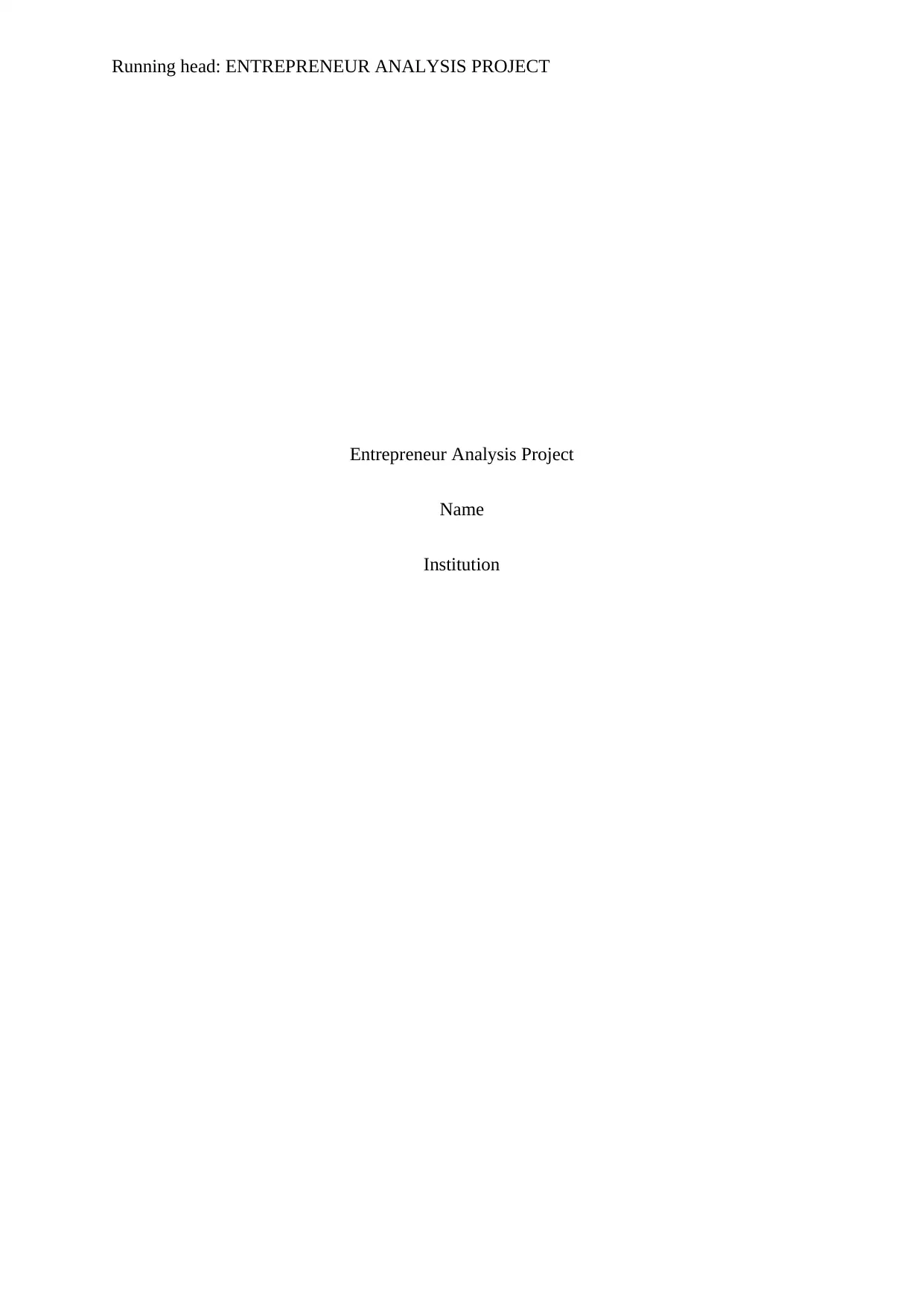
Running head: ENTREPRENEUR ANALYSIS PROJECT
Entrepreneur Analysis Project
Name
Institution
Entrepreneur Analysis Project
Name
Institution
Paraphrase This Document
Need a fresh take? Get an instant paraphrase of this document with our AI Paraphraser
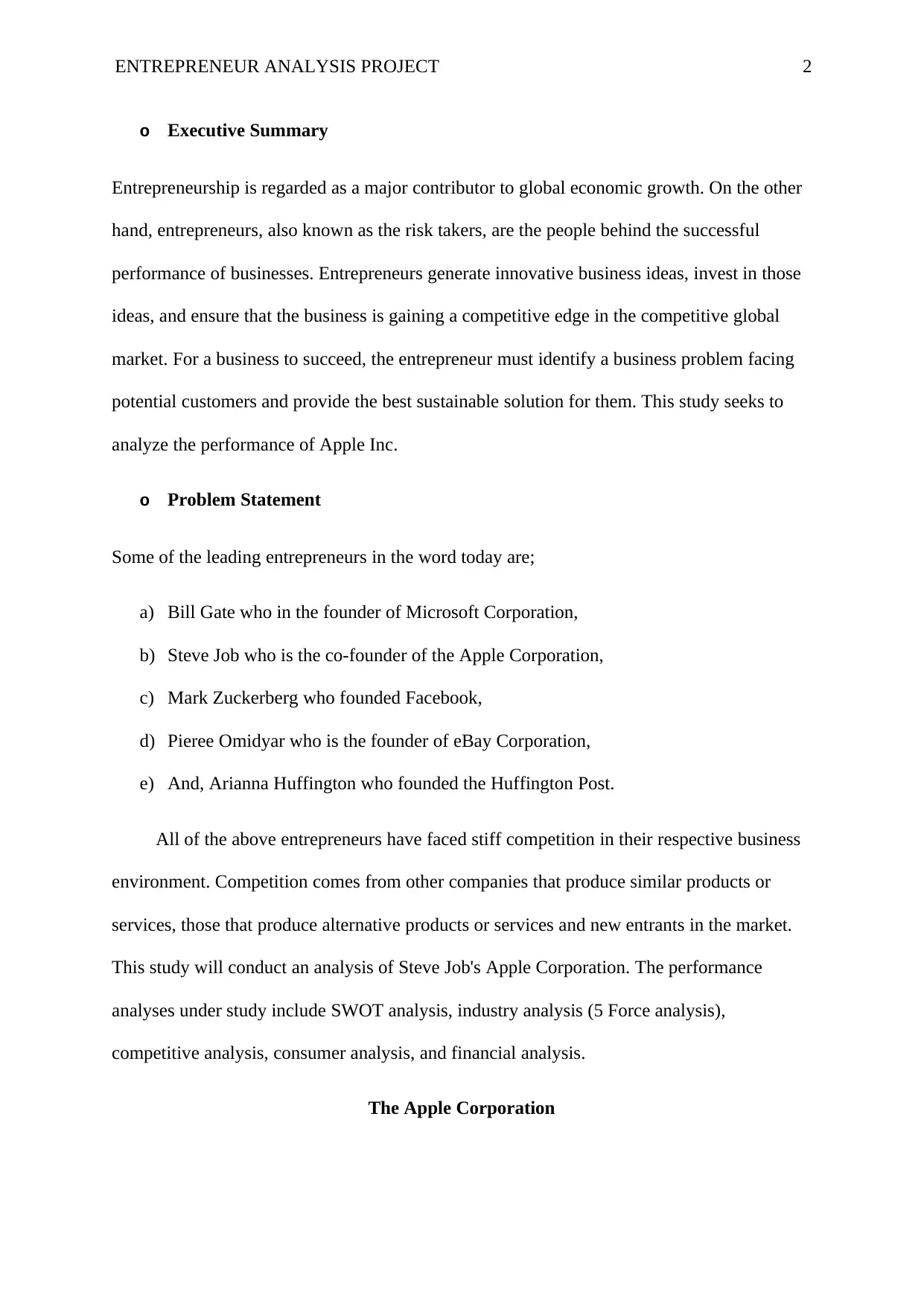
ENTREPRENEUR ANALYSIS PROJECT 2
o Executive Summary
Entrepreneurship is regarded as a major contributor to global economic growth. On the other
hand, entrepreneurs, also known as the risk takers, are the people behind the successful
performance of businesses. Entrepreneurs generate innovative business ideas, invest in those
ideas, and ensure that the business is gaining a competitive edge in the competitive global
market. For a business to succeed, the entrepreneur must identify a business problem facing
potential customers and provide the best sustainable solution for them. This study seeks to
analyze the performance of Apple Inc.
o Problem Statement
Some of the leading entrepreneurs in the word today are;
a) Bill Gate who in the founder of Microsoft Corporation,
b) Steve Job who is the co-founder of the Apple Corporation,
c) Mark Zuckerberg who founded Facebook,
d) Pieree Omidyar who is the founder of eBay Corporation,
e) And, Arianna Huffington who founded the Huffington Post.
All of the above entrepreneurs have faced stiff competition in their respective business
environment. Competition comes from other companies that produce similar products or
services, those that produce alternative products or services and new entrants in the market.
This study will conduct an analysis of Steve Job's Apple Corporation. The performance
analyses under study include SWOT analysis, industry analysis (5 Force analysis),
competitive analysis, consumer analysis, and financial analysis.
The Apple Corporation
o Executive Summary
Entrepreneurship is regarded as a major contributor to global economic growth. On the other
hand, entrepreneurs, also known as the risk takers, are the people behind the successful
performance of businesses. Entrepreneurs generate innovative business ideas, invest in those
ideas, and ensure that the business is gaining a competitive edge in the competitive global
market. For a business to succeed, the entrepreneur must identify a business problem facing
potential customers and provide the best sustainable solution for them. This study seeks to
analyze the performance of Apple Inc.
o Problem Statement
Some of the leading entrepreneurs in the word today are;
a) Bill Gate who in the founder of Microsoft Corporation,
b) Steve Job who is the co-founder of the Apple Corporation,
c) Mark Zuckerberg who founded Facebook,
d) Pieree Omidyar who is the founder of eBay Corporation,
e) And, Arianna Huffington who founded the Huffington Post.
All of the above entrepreneurs have faced stiff competition in their respective business
environment. Competition comes from other companies that produce similar products or
services, those that produce alternative products or services and new entrants in the market.
This study will conduct an analysis of Steve Job's Apple Corporation. The performance
analyses under study include SWOT analysis, industry analysis (5 Force analysis),
competitive analysis, consumer analysis, and financial analysis.
The Apple Corporation
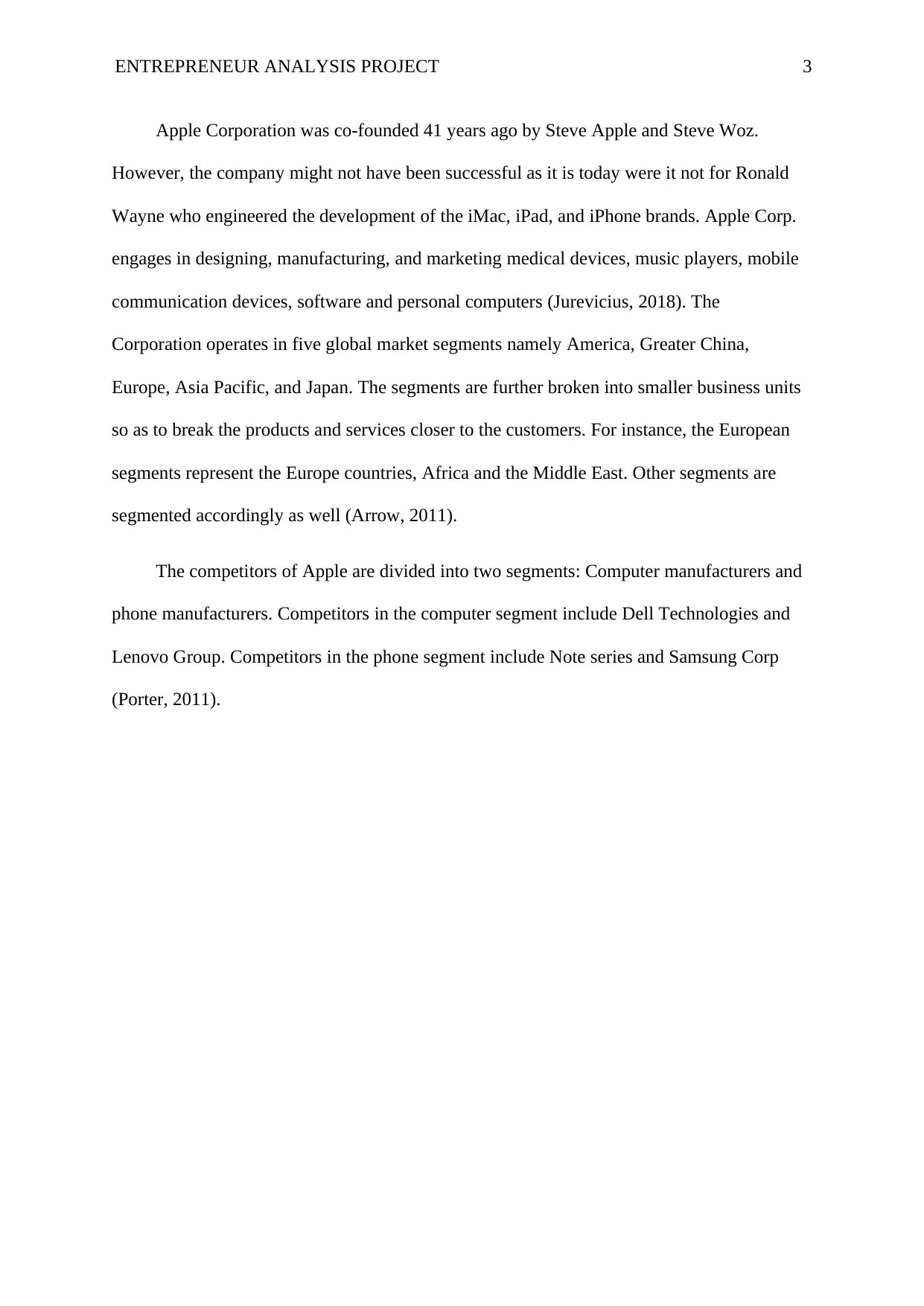
ENTREPRENEUR ANALYSIS PROJECT 3
Apple Corporation was co-founded 41 years ago by Steve Apple and Steve Woz.
However, the company might not have been successful as it is today were it not for Ronald
Wayne who engineered the development of the iMac, iPad, and iPhone brands. Apple Corp.
engages in designing, manufacturing, and marketing medical devices, music players, mobile
communication devices, software and personal computers (Jurevicius, 2018). The
Corporation operates in five global market segments namely America, Greater China,
Europe, Asia Pacific, and Japan. The segments are further broken into smaller business units
so as to break the products and services closer to the customers. For instance, the European
segments represent the Europe countries, Africa and the Middle East. Other segments are
segmented accordingly as well (Arrow, 2011).
The competitors of Apple are divided into two segments: Computer manufacturers and
phone manufacturers. Competitors in the computer segment include Dell Technologies and
Lenovo Group. Competitors in the phone segment include Note series and Samsung Corp
(Porter, 2011).
Apple Corporation was co-founded 41 years ago by Steve Apple and Steve Woz.
However, the company might not have been successful as it is today were it not for Ronald
Wayne who engineered the development of the iMac, iPad, and iPhone brands. Apple Corp.
engages in designing, manufacturing, and marketing medical devices, music players, mobile
communication devices, software and personal computers (Jurevicius, 2018). The
Corporation operates in five global market segments namely America, Greater China,
Europe, Asia Pacific, and Japan. The segments are further broken into smaller business units
so as to break the products and services closer to the customers. For instance, the European
segments represent the Europe countries, Africa and the Middle East. Other segments are
segmented accordingly as well (Arrow, 2011).
The competitors of Apple are divided into two segments: Computer manufacturers and
phone manufacturers. Competitors in the computer segment include Dell Technologies and
Lenovo Group. Competitors in the phone segment include Note series and Samsung Corp
(Porter, 2011).
⊘ This is a preview!⊘
Do you want full access?
Subscribe today to unlock all pages.

Trusted by 1+ million students worldwide
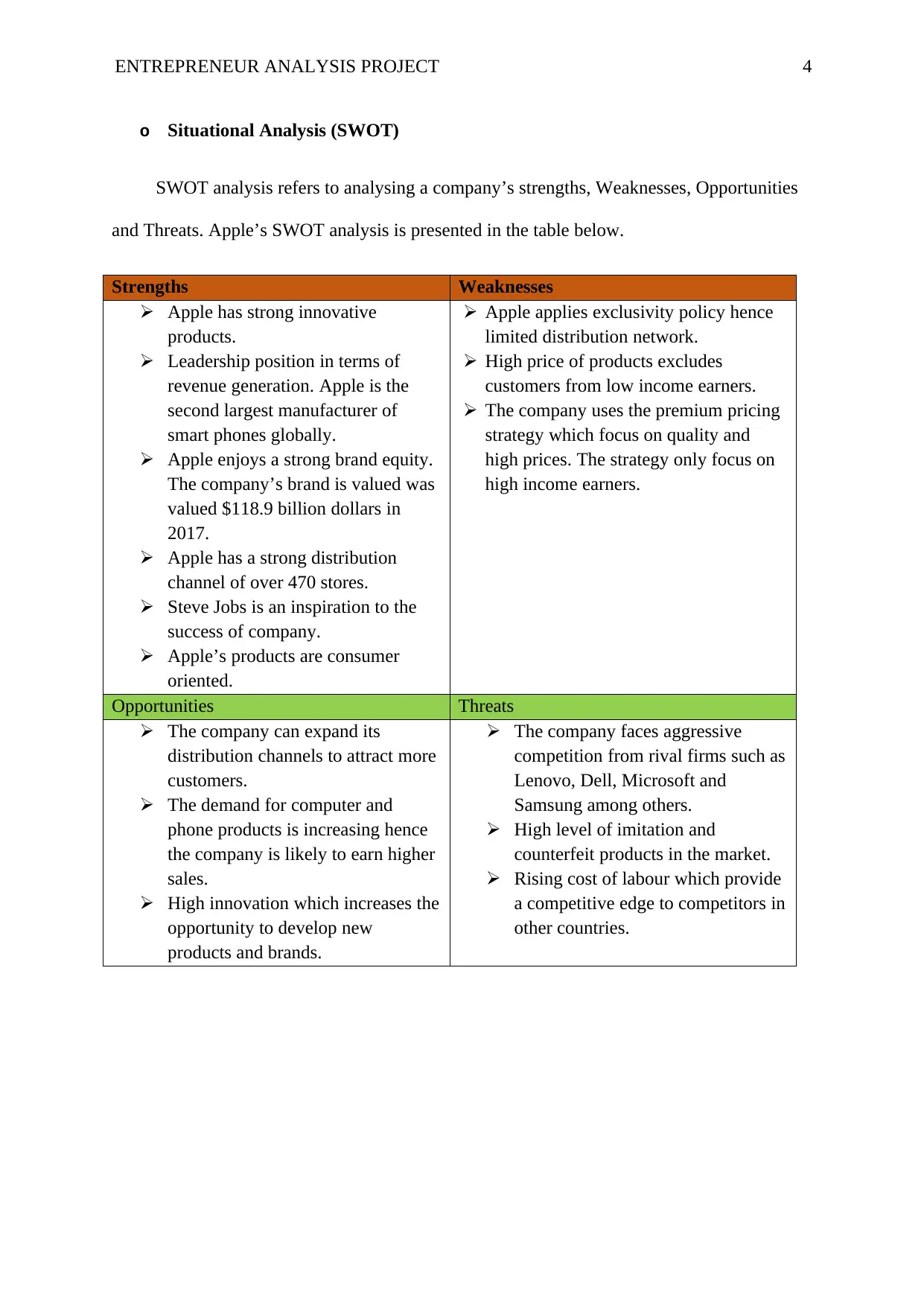
ENTREPRENEUR ANALYSIS PROJECT 4
o Situational Analysis (SWOT)
SWOT analysis refers to analysing a company’s strengths, Weaknesses, Opportunities
and Threats. Apple’s SWOT analysis is presented in the table below.
Strengths Weaknesses
Apple has strong innovative
products.
Leadership position in terms of
revenue generation. Apple is the
second largest manufacturer of
smart phones globally.
Apple enjoys a strong brand equity.
The company’s brand is valued was
valued $118.9 billion dollars in
2017.
Apple has a strong distribution
channel of over 470 stores.
Steve Jobs is an inspiration to the
success of company.
Apple’s products are consumer
oriented.
Apple applies exclusivity policy hence
limited distribution network.
High price of products excludes
customers from low income earners.
The company uses the premium pricing
strategy which focus on quality and
high prices. The strategy only focus on
high income earners.
Opportunities Threats
The company can expand its
distribution channels to attract more
customers.
The demand for computer and
phone products is increasing hence
the company is likely to earn higher
sales.
High innovation which increases the
opportunity to develop new
products and brands.
The company faces aggressive
competition from rival firms such as
Lenovo, Dell, Microsoft and
Samsung among others.
High level of imitation and
counterfeit products in the market.
Rising cost of labour which provide
a competitive edge to competitors in
other countries.
o Situational Analysis (SWOT)
SWOT analysis refers to analysing a company’s strengths, Weaknesses, Opportunities
and Threats. Apple’s SWOT analysis is presented in the table below.
Strengths Weaknesses
Apple has strong innovative
products.
Leadership position in terms of
revenue generation. Apple is the
second largest manufacturer of
smart phones globally.
Apple enjoys a strong brand equity.
The company’s brand is valued was
valued $118.9 billion dollars in
2017.
Apple has a strong distribution
channel of over 470 stores.
Steve Jobs is an inspiration to the
success of company.
Apple’s products are consumer
oriented.
Apple applies exclusivity policy hence
limited distribution network.
High price of products excludes
customers from low income earners.
The company uses the premium pricing
strategy which focus on quality and
high prices. The strategy only focus on
high income earners.
Opportunities Threats
The company can expand its
distribution channels to attract more
customers.
The demand for computer and
phone products is increasing hence
the company is likely to earn higher
sales.
High innovation which increases the
opportunity to develop new
products and brands.
The company faces aggressive
competition from rival firms such as
Lenovo, Dell, Microsoft and
Samsung among others.
High level of imitation and
counterfeit products in the market.
Rising cost of labour which provide
a competitive edge to competitors in
other countries.
Paraphrase This Document
Need a fresh take? Get an instant paraphrase of this document with our AI Paraphraser
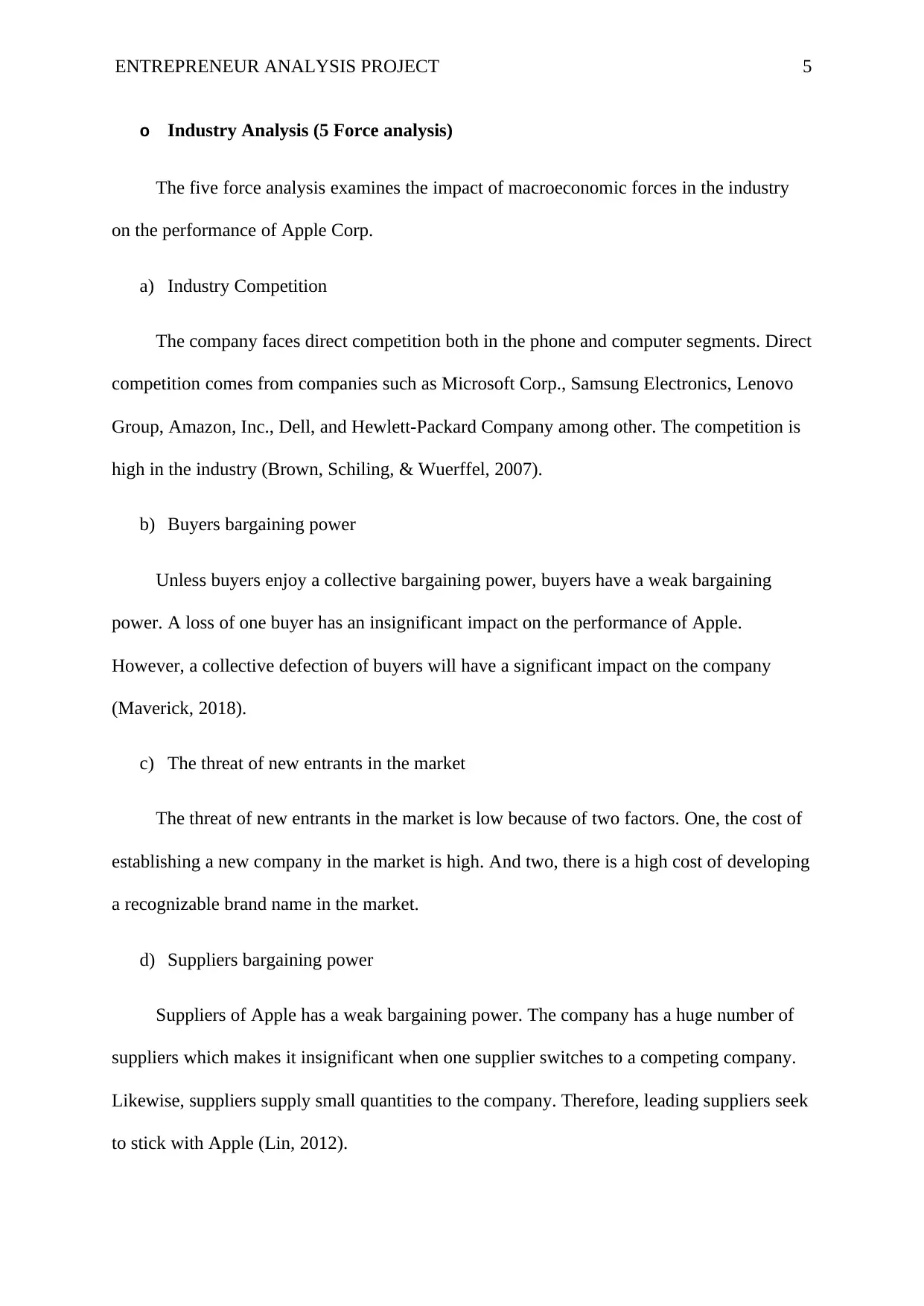
ENTREPRENEUR ANALYSIS PROJECT 5
o Industry Analysis (5 Force analysis)
The five force analysis examines the impact of macroeconomic forces in the industry
on the performance of Apple Corp.
a) Industry Competition
The company faces direct competition both in the phone and computer segments. Direct
competition comes from companies such as Microsoft Corp., Samsung Electronics, Lenovo
Group, Amazon, Inc., Dell, and Hewlett-Packard Company among other. The competition is
high in the industry (Brown, Schiling, & Wuerffel, 2007).
b) Buyers bargaining power
Unless buyers enjoy a collective bargaining power, buyers have a weak bargaining
power. A loss of one buyer has an insignificant impact on the performance of Apple.
However, a collective defection of buyers will have a significant impact on the company
(Maverick, 2018).
c) The threat of new entrants in the market
The threat of new entrants in the market is low because of two factors. One, the cost of
establishing a new company in the market is high. And two, there is a high cost of developing
a recognizable brand name in the market.
d) Suppliers bargaining power
Suppliers of Apple has a weak bargaining power. The company has a huge number of
suppliers which makes it insignificant when one supplier switches to a competing company.
Likewise, suppliers supply small quantities to the company. Therefore, leading suppliers seek
to stick with Apple (Lin, 2012).
o Industry Analysis (5 Force analysis)
The five force analysis examines the impact of macroeconomic forces in the industry
on the performance of Apple Corp.
a) Industry Competition
The company faces direct competition both in the phone and computer segments. Direct
competition comes from companies such as Microsoft Corp., Samsung Electronics, Lenovo
Group, Amazon, Inc., Dell, and Hewlett-Packard Company among other. The competition is
high in the industry (Brown, Schiling, & Wuerffel, 2007).
b) Buyers bargaining power
Unless buyers enjoy a collective bargaining power, buyers have a weak bargaining
power. A loss of one buyer has an insignificant impact on the performance of Apple.
However, a collective defection of buyers will have a significant impact on the company
(Maverick, 2018).
c) The threat of new entrants in the market
The threat of new entrants in the market is low because of two factors. One, the cost of
establishing a new company in the market is high. And two, there is a high cost of developing
a recognizable brand name in the market.
d) Suppliers bargaining power
Suppliers of Apple has a weak bargaining power. The company has a huge number of
suppliers which makes it insignificant when one supplier switches to a competing company.
Likewise, suppliers supply small quantities to the company. Therefore, leading suppliers seek
to stick with Apple (Lin, 2012).
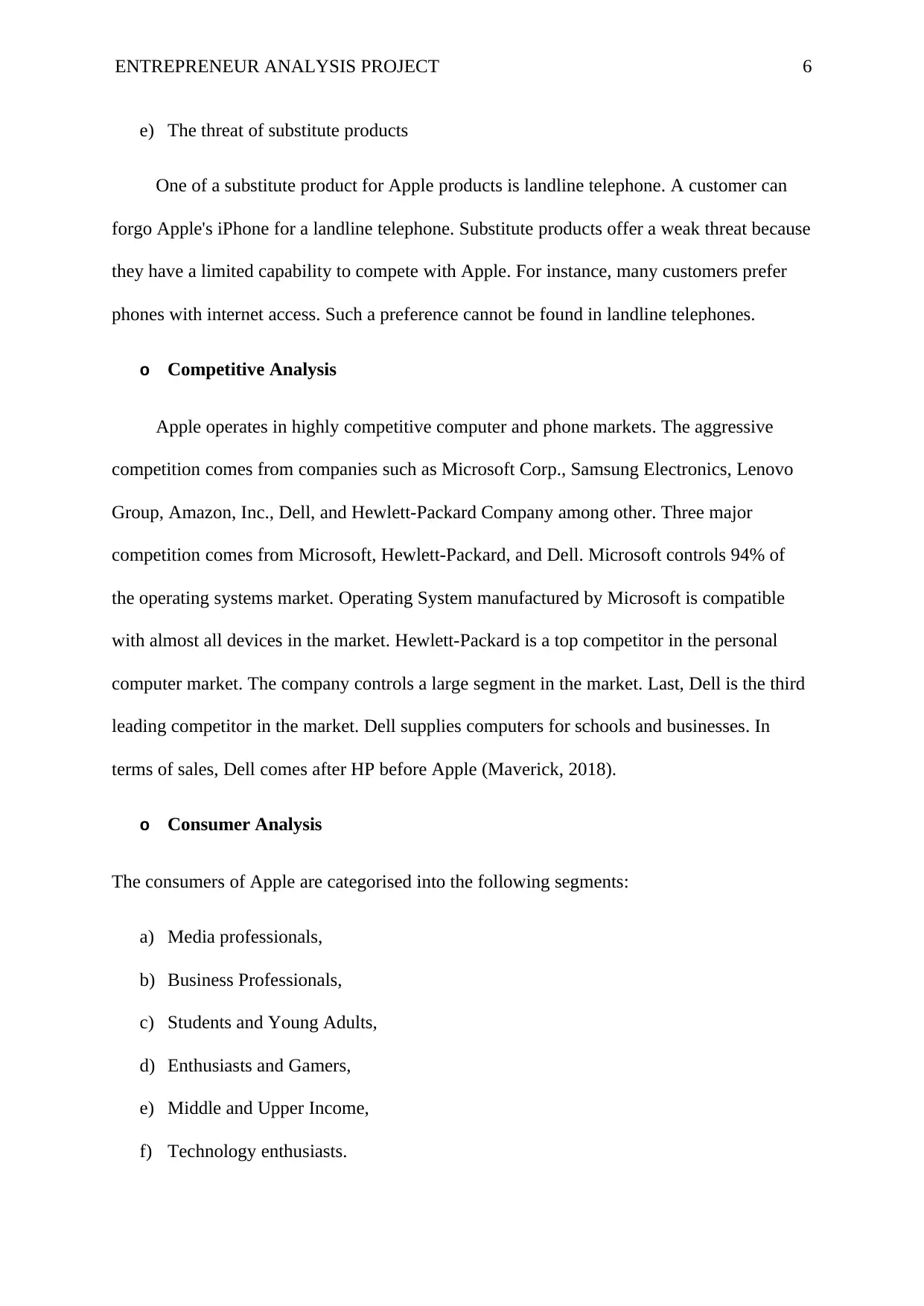
ENTREPRENEUR ANALYSIS PROJECT 6
e) The threat of substitute products
One of a substitute product for Apple products is landline telephone. A customer can
forgo Apple's iPhone for a landline telephone. Substitute products offer a weak threat because
they have a limited capability to compete with Apple. For instance, many customers prefer
phones with internet access. Such a preference cannot be found in landline telephones.
o Competitive Analysis
Apple operates in highly competitive computer and phone markets. The aggressive
competition comes from companies such as Microsoft Corp., Samsung Electronics, Lenovo
Group, Amazon, Inc., Dell, and Hewlett-Packard Company among other. Three major
competition comes from Microsoft, Hewlett-Packard, and Dell. Microsoft controls 94% of
the operating systems market. Operating System manufactured by Microsoft is compatible
with almost all devices in the market. Hewlett-Packard is a top competitor in the personal
computer market. The company controls a large segment in the market. Last, Dell is the third
leading competitor in the market. Dell supplies computers for schools and businesses. In
terms of sales, Dell comes after HP before Apple (Maverick, 2018).
o Consumer Analysis
The consumers of Apple are categorised into the following segments:
a) Media professionals,
b) Business Professionals,
c) Students and Young Adults,
d) Enthusiasts and Gamers,
e) Middle and Upper Income,
f) Technology enthusiasts.
e) The threat of substitute products
One of a substitute product for Apple products is landline telephone. A customer can
forgo Apple's iPhone for a landline telephone. Substitute products offer a weak threat because
they have a limited capability to compete with Apple. For instance, many customers prefer
phones with internet access. Such a preference cannot be found in landline telephones.
o Competitive Analysis
Apple operates in highly competitive computer and phone markets. The aggressive
competition comes from companies such as Microsoft Corp., Samsung Electronics, Lenovo
Group, Amazon, Inc., Dell, and Hewlett-Packard Company among other. Three major
competition comes from Microsoft, Hewlett-Packard, and Dell. Microsoft controls 94% of
the operating systems market. Operating System manufactured by Microsoft is compatible
with almost all devices in the market. Hewlett-Packard is a top competitor in the personal
computer market. The company controls a large segment in the market. Last, Dell is the third
leading competitor in the market. Dell supplies computers for schools and businesses. In
terms of sales, Dell comes after HP before Apple (Maverick, 2018).
o Consumer Analysis
The consumers of Apple are categorised into the following segments:
a) Media professionals,
b) Business Professionals,
c) Students and Young Adults,
d) Enthusiasts and Gamers,
e) Middle and Upper Income,
f) Technology enthusiasts.
⊘ This is a preview!⊘
Do you want full access?
Subscribe today to unlock all pages.

Trusted by 1+ million students worldwide
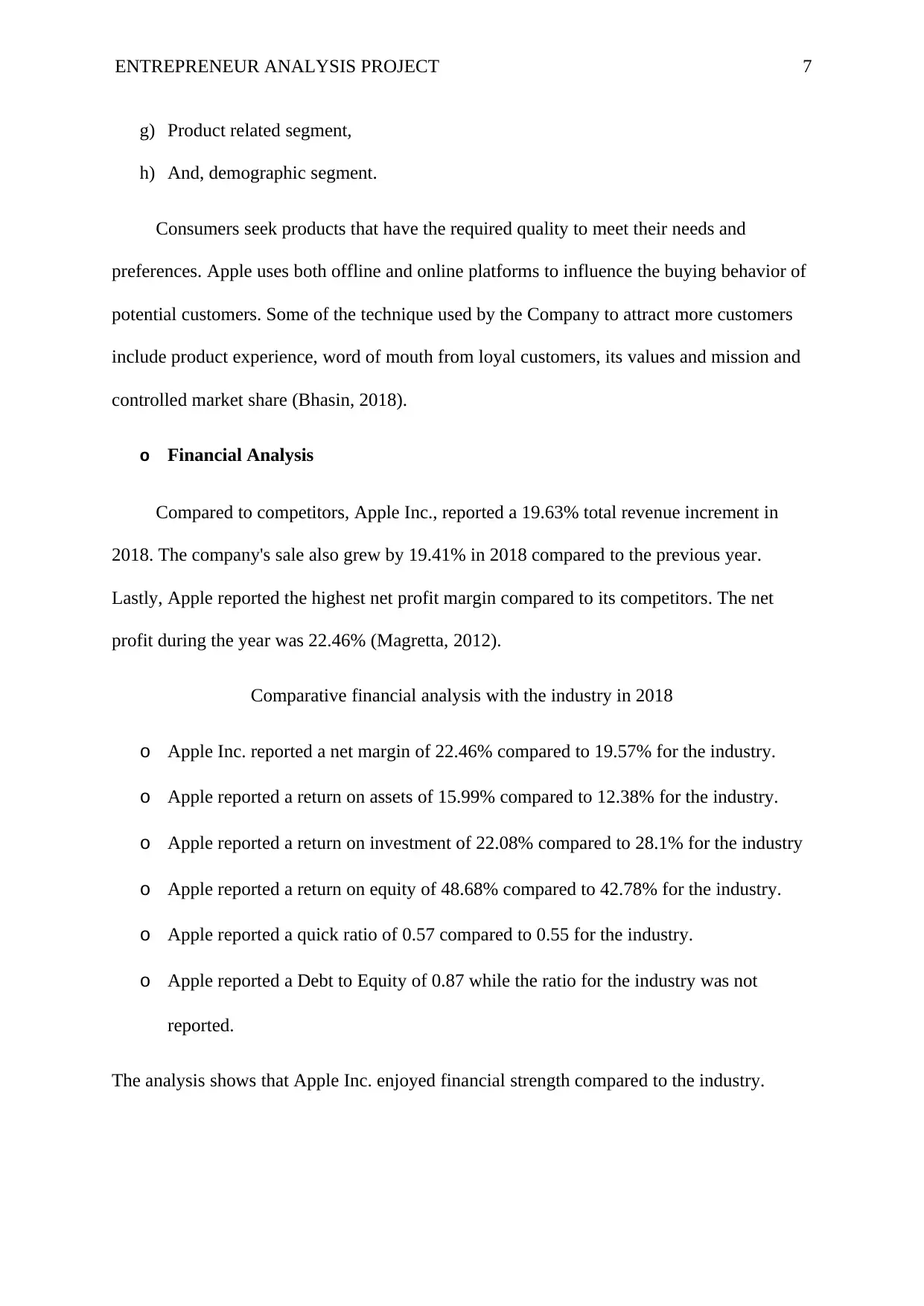
ENTREPRENEUR ANALYSIS PROJECT 7
g) Product related segment,
h) And, demographic segment.
Consumers seek products that have the required quality to meet their needs and
preferences. Apple uses both offline and online platforms to influence the buying behavior of
potential customers. Some of the technique used by the Company to attract more customers
include product experience, word of mouth from loyal customers, its values and mission and
controlled market share (Bhasin, 2018).
o Financial Analysis
Compared to competitors, Apple Inc., reported a 19.63% total revenue increment in
2018. The company's sale also grew by 19.41% in 2018 compared to the previous year.
Lastly, Apple reported the highest net profit margin compared to its competitors. The net
profit during the year was 22.46% (Magretta, 2012).
Comparative financial analysis with the industry in 2018
o Apple Inc. reported a net margin of 22.46% compared to 19.57% for the industry.
o Apple reported a return on assets of 15.99% compared to 12.38% for the industry.
o Apple reported a return on investment of 22.08% compared to 28.1% for the industry
o Apple reported a return on equity of 48.68% compared to 42.78% for the industry.
o Apple reported a quick ratio of 0.57 compared to 0.55 for the industry.
o Apple reported a Debt to Equity of 0.87 while the ratio for the industry was not
reported.
The analysis shows that Apple Inc. enjoyed financial strength compared to the industry.
g) Product related segment,
h) And, demographic segment.
Consumers seek products that have the required quality to meet their needs and
preferences. Apple uses both offline and online platforms to influence the buying behavior of
potential customers. Some of the technique used by the Company to attract more customers
include product experience, word of mouth from loyal customers, its values and mission and
controlled market share (Bhasin, 2018).
o Financial Analysis
Compared to competitors, Apple Inc., reported a 19.63% total revenue increment in
2018. The company's sale also grew by 19.41% in 2018 compared to the previous year.
Lastly, Apple reported the highest net profit margin compared to its competitors. The net
profit during the year was 22.46% (Magretta, 2012).
Comparative financial analysis with the industry in 2018
o Apple Inc. reported a net margin of 22.46% compared to 19.57% for the industry.
o Apple reported a return on assets of 15.99% compared to 12.38% for the industry.
o Apple reported a return on investment of 22.08% compared to 28.1% for the industry
o Apple reported a return on equity of 48.68% compared to 42.78% for the industry.
o Apple reported a quick ratio of 0.57 compared to 0.55 for the industry.
o Apple reported a Debt to Equity of 0.87 while the ratio for the industry was not
reported.
The analysis shows that Apple Inc. enjoyed financial strength compared to the industry.
Paraphrase This Document
Need a fresh take? Get an instant paraphrase of this document with our AI Paraphraser
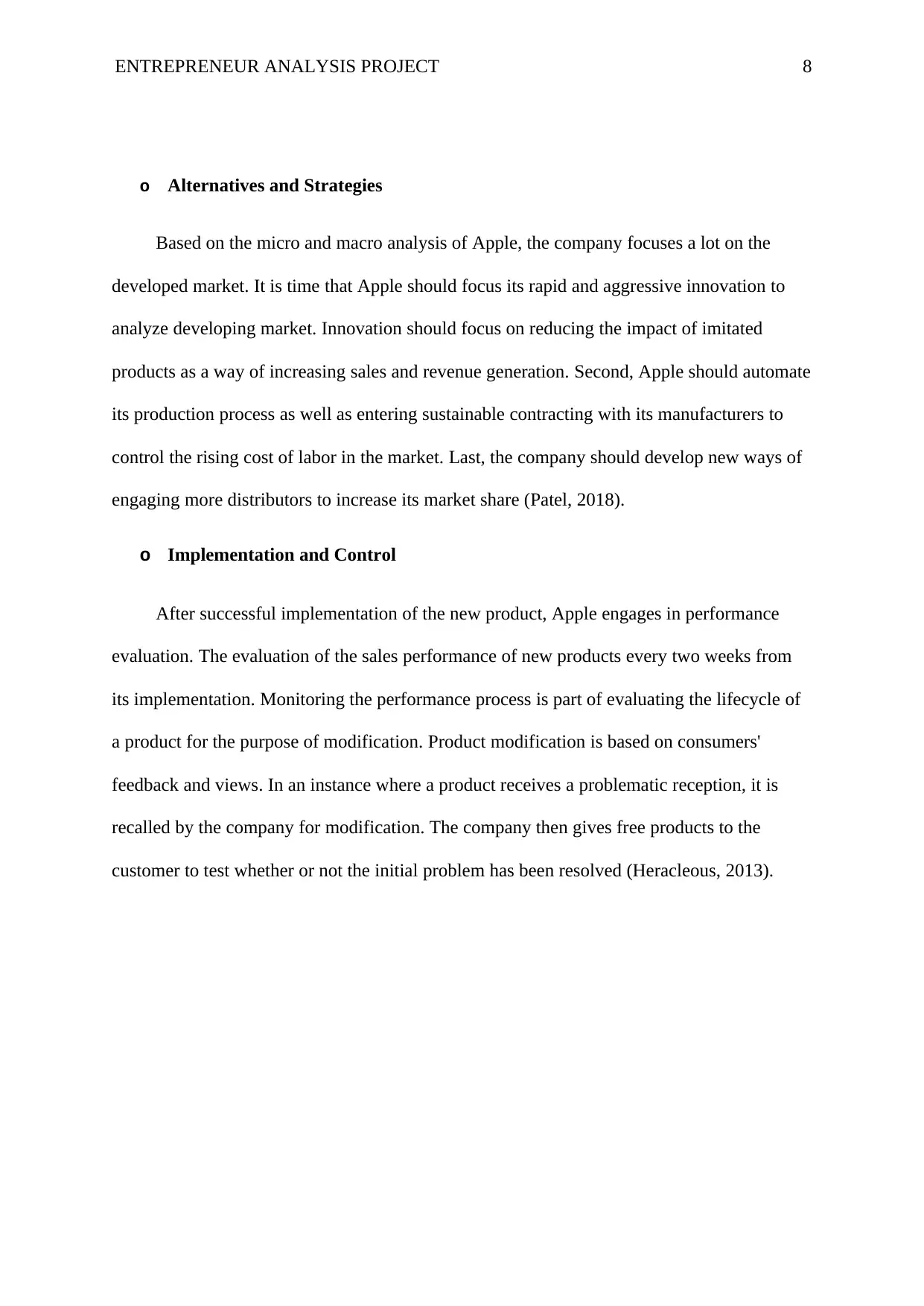
ENTREPRENEUR ANALYSIS PROJECT 8
o Alternatives and Strategies
Based on the micro and macro analysis of Apple, the company focuses a lot on the
developed market. It is time that Apple should focus its rapid and aggressive innovation to
analyze developing market. Innovation should focus on reducing the impact of imitated
products as a way of increasing sales and revenue generation. Second, Apple should automate
its production process as well as entering sustainable contracting with its manufacturers to
control the rising cost of labor in the market. Last, the company should develop new ways of
engaging more distributors to increase its market share (Patel, 2018).
o Implementation and Control
After successful implementation of the new product, Apple engages in performance
evaluation. The evaluation of the sales performance of new products every two weeks from
its implementation. Monitoring the performance process is part of evaluating the lifecycle of
a product for the purpose of modification. Product modification is based on consumers'
feedback and views. In an instance where a product receives a problematic reception, it is
recalled by the company for modification. The company then gives free products to the
customer to test whether or not the initial problem has been resolved (Heracleous, 2013).
o Alternatives and Strategies
Based on the micro and macro analysis of Apple, the company focuses a lot on the
developed market. It is time that Apple should focus its rapid and aggressive innovation to
analyze developing market. Innovation should focus on reducing the impact of imitated
products as a way of increasing sales and revenue generation. Second, Apple should automate
its production process as well as entering sustainable contracting with its manufacturers to
control the rising cost of labor in the market. Last, the company should develop new ways of
engaging more distributors to increase its market share (Patel, 2018).
o Implementation and Control
After successful implementation of the new product, Apple engages in performance
evaluation. The evaluation of the sales performance of new products every two weeks from
its implementation. Monitoring the performance process is part of evaluating the lifecycle of
a product for the purpose of modification. Product modification is based on consumers'
feedback and views. In an instance where a product receives a problematic reception, it is
recalled by the company for modification. The company then gives free products to the
customer to test whether or not the initial problem has been resolved (Heracleous, 2013).
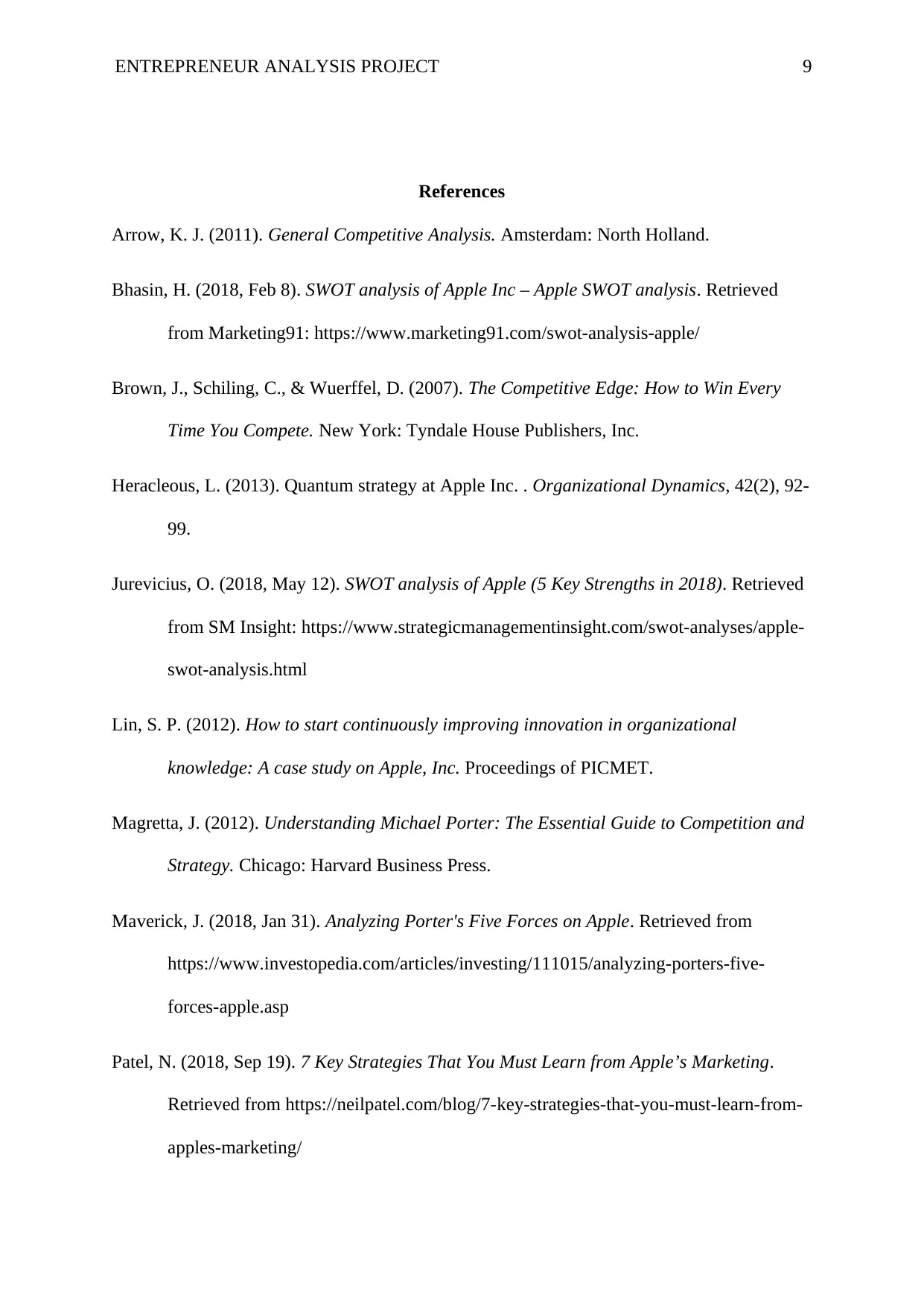
ENTREPRENEUR ANALYSIS PROJECT 9
References
Arrow, K. J. (2011). General Competitive Analysis. Amsterdam: North Holland.
Bhasin, H. (2018, Feb 8). SWOT analysis of Apple Inc – Apple SWOT analysis. Retrieved
from Marketing91: https://www.marketing91.com/swot-analysis-apple/
Brown, J., Schiling, C., & Wuerffel, D. (2007). The Competitive Edge: How to Win Every
Time You Compete. New York: Tyndale House Publishers, Inc.
Heracleous, L. (2013). Quantum strategy at Apple Inc. . Organizational Dynamics, 42(2), 92-
99.
Jurevicius, O. (2018, May 12). SWOT analysis of Apple (5 Key Strengths in 2018). Retrieved
from SM Insight: https://www.strategicmanagementinsight.com/swot-analyses/apple-
swot-analysis.html
Lin, S. P. (2012). How to start continuously improving innovation in organizational
knowledge: A case study on Apple, Inc. Proceedings of PICMET.
Magretta, J. (2012). Understanding Michael Porter: The Essential Guide to Competition and
Strategy. Chicago: Harvard Business Press.
Maverick, J. (2018, Jan 31). Analyzing Porter's Five Forces on Apple. Retrieved from
https://www.investopedia.com/articles/investing/111015/analyzing-porters-five-
forces-apple.asp
Patel, N. (2018, Sep 19). 7 Key Strategies That You Must Learn from Apple’s Marketing.
Retrieved from https://neilpatel.com/blog/7-key-strategies-that-you-must-learn-from-
apples-marketing/
References
Arrow, K. J. (2011). General Competitive Analysis. Amsterdam: North Holland.
Bhasin, H. (2018, Feb 8). SWOT analysis of Apple Inc – Apple SWOT analysis. Retrieved
from Marketing91: https://www.marketing91.com/swot-analysis-apple/
Brown, J., Schiling, C., & Wuerffel, D. (2007). The Competitive Edge: How to Win Every
Time You Compete. New York: Tyndale House Publishers, Inc.
Heracleous, L. (2013). Quantum strategy at Apple Inc. . Organizational Dynamics, 42(2), 92-
99.
Jurevicius, O. (2018, May 12). SWOT analysis of Apple (5 Key Strengths in 2018). Retrieved
from SM Insight: https://www.strategicmanagementinsight.com/swot-analyses/apple-
swot-analysis.html
Lin, S. P. (2012). How to start continuously improving innovation in organizational
knowledge: A case study on Apple, Inc. Proceedings of PICMET.
Magretta, J. (2012). Understanding Michael Porter: The Essential Guide to Competition and
Strategy. Chicago: Harvard Business Press.
Maverick, J. (2018, Jan 31). Analyzing Porter's Five Forces on Apple. Retrieved from
https://www.investopedia.com/articles/investing/111015/analyzing-porters-five-
forces-apple.asp
Patel, N. (2018, Sep 19). 7 Key Strategies That You Must Learn from Apple’s Marketing.
Retrieved from https://neilpatel.com/blog/7-key-strategies-that-you-must-learn-from-
apples-marketing/
⊘ This is a preview!⊘
Do you want full access?
Subscribe today to unlock all pages.

Trusted by 1+ million students worldwide
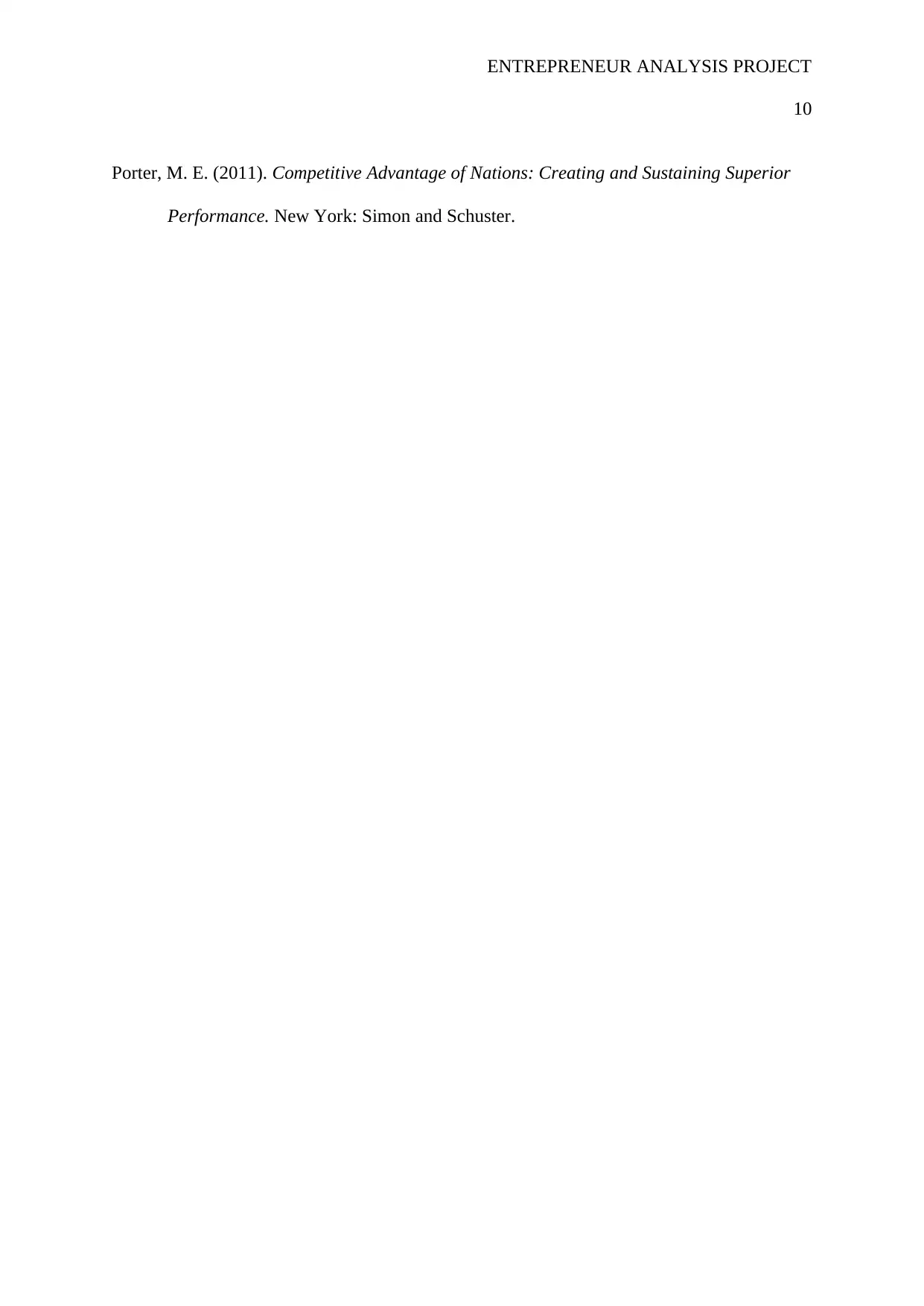
ENTREPRENEUR ANALYSIS PROJECT
10
Porter, M. E. (2011). Competitive Advantage of Nations: Creating and Sustaining Superior
Performance. New York: Simon and Schuster.
10
Porter, M. E. (2011). Competitive Advantage of Nations: Creating and Sustaining Superior
Performance. New York: Simon and Schuster.
1 out of 10
Related Documents
Your All-in-One AI-Powered Toolkit for Academic Success.
+13062052269
info@desklib.com
Available 24*7 on WhatsApp / Email
![[object Object]](/_next/static/media/star-bottom.7253800d.svg)
Unlock your academic potential
Copyright © 2020–2025 A2Z Services. All Rights Reserved. Developed and managed by ZUCOL.





